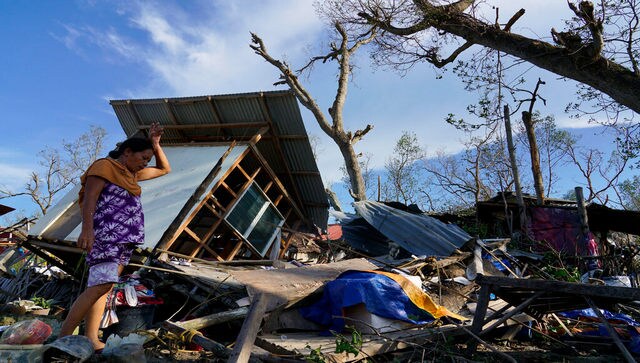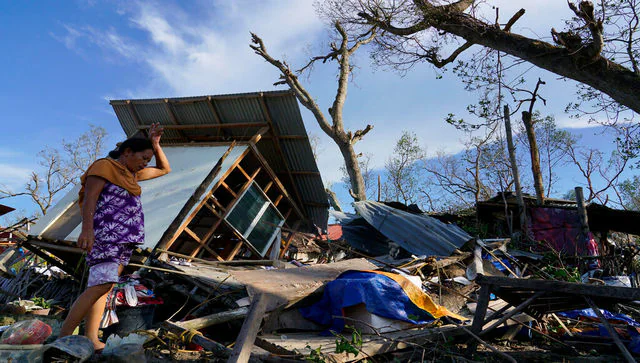While Typhoon Rai toll rises to 375, here’s a look at other storms that plagued the Phillipines this past decade
[ad_1]
While typhoons are no strangers to the Phillipines, there is a never-ending trail of devastation left behind each time in terms of human lives, resources and economic distress, apart from homelessness and livelihood loss.

A resident salvages parts of her home damaged by to Typhoon Rai in Talisay, Cebu province. AP
The death toll from the strongest typhoon to hit the Philippines this year surged to 375 on Monday.
Torn roofs, uprooted trees, toppled concrete power poles, wooden houses smashed to smithereens, destroyed crops and flooded villages are a few of the things that Typhoon Rai unleashed on the archipelago (an extensive group of islands), as desperate survivors pleaded for urgent supplies of drinking water and food.
The Philippine Red Cross reported “complete carnage” in coastal areas after Super Typhoon Rai left homes, hospitals and schools “ripped to shreds”.
The calamity sparked comparisons to the damage caused by Super Typhoon Haiyan in Phillipines in 2013, which brings us to exploring the worst typhoons witnessed by the Phillipines in the past decade.
Typhoon Mangkhut, 2018
Typhoon Mangkhut, known in the Phillipines as Typhoon Ompong (Category 4), struck on 15 September 2018. More than a 100 casualties were reported, while many went missing.
It was reportedly the strongest storm to strike the Phillipines in 2018. The category five super-typhoon, with more than 5 million people in its path, hit the northern end of the island of Luzon, with winds of 200km/hour (125 mph) and gusts reaching up to 330km/hour.
High winds ripped roofs off houses, pulled down trees and electricity pylons. Rains caused fatal landslides and flooding as well.
Typhoon Meranti, 2016
Typhoon Meranti (internationally known as Super Typhoon Ferdie), was one of the strongest to hit the Phillipines in more than two decades, after it made landfall last 14 September, 2016.
The storm sustained maximum strength of 255 km/hour and extensively damaged the Batanes’ agriculture sector and infrastructure, amounting to Philippine peso (PhP) 835 million, approximately $167.5 million.
It affected 2,891 families or 61% of the total population, mostly of which came from the municipalities of Basco and Itbayat that were the hardest hit areas. However, there were no reported cases of death, and only 12 minor injuries.
Super Typhoon Glenda, 2014
Typhoon Glenda (Rammasun), is one of the only three Category 5 typhoons to hit the Phillipines, including the most recent Rai. It made its landfall on 15 July, 2014, in Rapu-Rapu, Albay.
The typhoon affected Philippines, South China, and Vietnam.
With gusts of up to 185km/hour (115 mph), Typhoon Rammasun swept through the Philippines on Wednesday, leaving 40 dead and 17 injured, according to the government disaster management agency, as per an LA Times report.
Super Typhoon Haiyan, 2013
As per an NYT report, Super Typhoon Haiyan, also known as Super Typhoon Yolanda, saw seawater rise up to 30 feet, drowning more than 6,000 people and left 1,800 missing.
A satellite estimated Typhoon Haiyan’s wind speeds to be as high as 195 miles per hour, one of the highest ever recorded on Earth.
The destruction recorded as the highest in the city where the storm made landfall, Tacloban. The aftermath was a horrifying sight with thousands of bodies lining the roadsides, clustered indoors or stuck in bushes and trees.
The storm displaced nearly four million people. For the survivors, food, water and medicines were hard to come by. So much so that a Red Cross convoy faced rioting mobs of hungry survivors who tried looting it. This prevented the convoy from proceeding and help failed to reach the devastated parts until days later.
Super Typhoon Pablo, 2012
Typhoon Pablo (Bopha) made landfall on 3 December, 2012, as a Category 5 super typhoon over the southern Filipino island of Mindanao – leaving thousands of people homeless and 1,901 dead.
The typhoon boasted winds of 280 km/hour, flooding and devastating the region. Most areas of eastern Mindanao experienced 3.9 inches of rain.
The typhoon made landfall thrice in the Phillipines and due to the remote nature of the area most affected, many were unable to receive aid quickly. Farmland, a primary source of income for people living in the region, were vastly damaged. Immediately following the typhoon, officials estimated that 18 bridges and 16 roads were damaged, leaving some areas accessible only by sea or air.
While typhoons are no strangers to the Phillipines, there is a never-ending trail of devastation left behind each time in terms of human lives, resources and economic distress, apart from homelessness and livelihood loss.
Read all the Latest News, Trending News, Cricket News, Bollywood News,
India News and Entertainment News here. Follow us on Facebook, Twitter and Instagram
[ad_2]
Source link


Comments are closed.